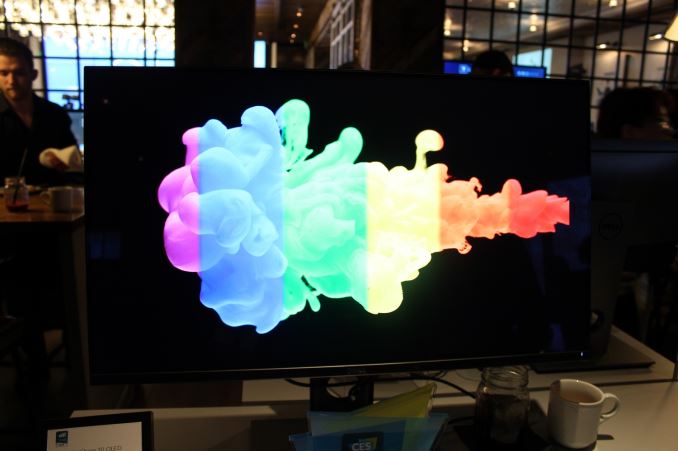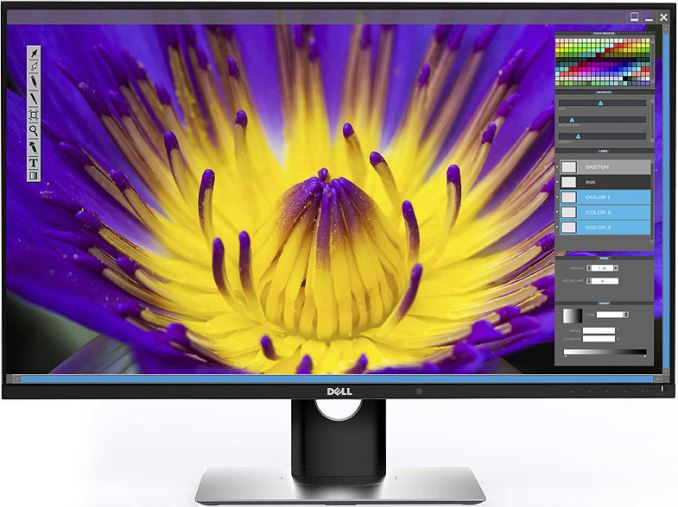Dell Demonstrates 30-inch 4K OLED Display
by Anton Shilov on January 7, 2016 6:40 PM EST- Posted in
- Monitors
- Dell
- Trade Shows
- 4K
- Ultrasharp
- CES 2016
- 30"
- OLED
- UP3017Q

Dell does not produce its own display panels, but when it comes to unique “world’s first” monitors, it is sometimes years ahead of all of its rivals. At the International CES 2016, Dell introduced its UltraSharp 30-inch OLED display, the company’s first monitor to use organic light emitting diode panel. The product is designed for professionals and carries a rather extreme price tag, but this is going to be a dream display for years to come.
The Dell UltraSharp UP3017Q is a 30-inch display with 3840×2160 resolution, 0.1 ms response time and an unknown refresh rate (yet, it should be very high). The monitor can reproduce 1.07 billion colors, it covers 100% of Adobe RGB color space as well as and 97.8% of DCI-P3 color space (used for digital movie projection by the U.S. movie industry and is expected to be adopted in televisions and in home cinema), according to Dell. Just a few professional displays nowadays cover 100% of Adobe RGB. The manufacturer declares 400,000:1 dynamic contrast ratio, but admits the value is only that because testing equipment won't go higher.
The UltraSharp UP3017Q ultra-high-definition display has very narrow bezels; the monitor itself is thin, but not remarkably thin like OLED TVs, possibly because it features internal power supply unit as well as complex logic inside. The monitor features a mini DisplayPort (mDP) connector, an HDMI port as well as a USB type-C port, which could be used for video and data connectivity as well as for power delivery (it can be powered using a type-C cable, or deliver power to another device).
Emissive electroluminescent layer in organic light-emitting diode is made of organic compound that emits light in response to an electric current. The organic semiconductor layer is situated between two electrodes and does not require a backlight. As a result, it can display truly deep black levels, unlike liquid crystal display (LCD) panels, which use various kinds of backlighting. Besides, since the emissive electroluminescent layer is very thin and can take different shapes, it is possible to build ultra-thin and even curved monitors and TVs using OLEDs.
While OLED technology can deliver deep blacks, high contrast ratio and exceptional colours, it is not free of drawbacks. The organic layer may burn down over prolonged amount of time, and colors can shift over time. To maximize lifespan of the OLED panel inside the UltraSharp UP3017Q, Dell integrated a special presence detector into the front panel of the display, which switches the monitor off when nobody uses it. Another disadvantage of OLEDs is a possibility of static image burn in. To reduce the chance of burn in, the UP3017Q has a special pixel-shifting technology.
The Dell UltraSharp 30 OLED monitor will cost whopping $4,999, which it becomes available on March 31, 2016, in the United States. The display at this point is only aimed at professionals, who work in color-critical environments such as graphic arts and photography. However, due to exceptional colors and contrast as well as ultra-fast response time, the UltraSharp UP3017Q will be a dream display for gamers, prosumers and other users, who value quality.
OLED panels are considerably more expensive to produce than modern LCD panels, partly because of lower yields. Last year an executive from LG Electronics said that yields of OLED panels had reached 80% and would continue to grow. At the International CES 2016, Kwon Bong-suk, the head of LG’s TV business, said that the company had cut prices of OLED TVs in the U.S. by 45% late in 2015. As a result, LG now expects sales of OLED televisions to triple this year. Price reduction of OLED TVs indicates that production costs of organic light-emitting diode panels are going down. Perhaps, over time, the Dell UltraSharp UP3017Q will also become more affordable, or Dell will release an OLED display for a wider audience.











83 Comments
View All Comments
daviderickson - Thursday, January 7, 2016 - link
OLED is expensive, and thus put into premium products. Even if they made what you wanted, they'd still probably charge $4k for it, and then you'd complain about the price. Plus, if you are asking for 120hz monitor then you must be using it for twitch games, and in said games you aren't going to have time to appreciate the color and contrast improvements an OLED delivers anyway.Airstuff16 - Friday, February 12, 2016 - link
I heard that OLEDs do not have refresh rates. Im not sure if thats true but I just wanna put that out there.nilepez - Thursday, January 7, 2016 - link
I'm pretty sure most people who buy 4k Monitors want more desktop space and/or more DPI. Gaming is not the primary target of 4k. OTOH, 4K + HDR TV is going to look great....better still if they support REC 2020 (don't think anyone does yet). At this point, I have 0 interest in 1440p. I'd sooner go to 5k and run games at 1440. I like gaming, but I wouldn't buy a monitor with 100% adobe coverage for gaming.They're not going with mainstream products, because they want to recoup R&D costs and the best way to do that is to release an expensive monitor. It's possible that the cost to make a 1440p monitor and a 4k monitor is not enough to get the price down to a level that you'd find acceptable. My gut says it'd be at least 2-3k and I suspect that's not a price most gamers are willing to pay. OTOH, this monitors closest competitor costs significantly more than it.
Azethoth - Thursday, January 7, 2016 - link
Your rant is ill informed. I am a programmer and started looking for a 4k display two years ago. The vizio was only 4kp30 so it went back because I need much faster feedback on the mouse and it was unuseable for programming. A few months later Asus came out with a fairly cheap 32" monitor that could pump out 4kp60. I am happy with that. The monitor is as wide as I want to go, more and there would be too much strain from moving my head around. The resolution is nice and with Windows 10 all the scaling issues are gone. I got a nice productivity increase over my old Apple 30" 2560x1600 monitor from 2003.So please note that these in between sizes you are suddenly pining for have been obsolete for more than a decade. It is high time for 4k gear to be out. 1440P OLED, gimme a break. Wake me up when I can upgrade my monitor to 4k OLED. 1440 does not even remotely cut it.
HollyDOL - Friday, January 8, 2016 - link
Hm, currently using 27" and 1440p... Compared to 30" and 2160p it doesn't seem to be that huge difference in pixel density (calculated that to 4k at 30" being 1.65 times more dense than 1440p at 27")... Don't think 4k at 30" would be an overkill of any kind. I can imagine using that on regular basis.ddriver - Friday, January 8, 2016 - link
Cannot help but LOL at your comment. Because if programming is demanding in any aspect, that would be "fast mouse feedback".FYI programmers work with text 99% of the time, couldn't care less about refresh rates, not that 30 is low by any measure, and barely use the mouse, since that's a lot slower than using keyboard shortcuts.
Next time pretend you are a gamer ;)
mr_tawan - Friday, January 8, 2016 - link
Well programming in the modern day requires screen space for integrated tool (IDE, that is). Personally I'm pretty ok with my 24" at 1080p (but I find Surface Pro is PITA to work with).Not every programmer works primarily on texts. Yes if you're on the console all the time, then even 800x600 would be suffcient. If you're web programmer, having larger screen can simulate the different screen sizes that might be used by differents users. If you're a game developer, a second screen is a must (or else your debugger can block everything in full-screen mode, which is the last thing you'd want), or even better a second set of PC to do remote debugging.
I think, in most case, multi-monitor is more useful than one large monitor. But then this is a personal preference.
ddriver - Friday, January 8, 2016 - link
Code is text, 99.999% of all programming is still textual, whether or not you are using an IDE. Interaction with the IDE is an insignificant amount of all the programming. For most of the frequently used things that a regular person would use the mouse, programmers use shortcuts, such as navigating over different source files, change cursor position, select text, run project and so on.But you missed the point - there is nothing in programming that calls for "fast mouse feedback", also that response time doesn't really depend on the monitor framerate at all, it depends on the monitor's input lag. The point was that guy was spewing ridiculous nonsense, clearly clueless what he is talking about.
thetuna - Friday, January 8, 2016 - link
I do web dev. 30Hz is feels like working through molasses, but it is not a detriment to productivity. What is a huge boon to productivity is resolution... my current ideal is a single 3440x1440 ~32".Why my work will not spend $600 to greatly boost my prductivity? I have no fukcing idea.
gochichi - Thursday, April 14, 2016 - link
I try to spend company cash on monitors. It's curturaly discouraged. We're in the minority, $3k laptop that expires in 2-3 years... sure no prob. Awesome $500-$900 monitor that will be amazing for 3-years and great for another 3-years and then very good for another 4-years... I must be crazy, why don't I just use a $100 monitor? (This is both management and end users.)